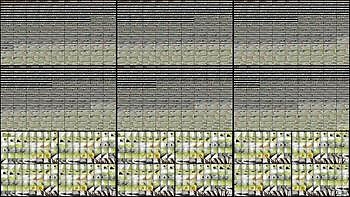Thomas Mohr selected images from his archive of more than 300,000 photographs. The construction method is based on the fundamental property of film, video, and animation: these are made up of a series of individual images. The process of composition is a repetitive procedure of compressing, stacking and filtering the images to create a model mirroring the development and rise of memory and the transformation from impressions to experience. The basic construction layers refer to film counterfoils – image by image – which constantly shift between single strip and full screen, and between horizontal and vertical patterns. As the patterns intensify, the base constructions are mathematically reprocessed, which introduces increasing compression and distance. Step by step the content and dimensions of the constructions increase and more and more processed perceptions are simultaneously registered. At higher processing levels, the same simple filter is added repeatedly, further emphasising the essence of the material.
Martijn Comes has used especially devised electro-acoustic instruments to create the sometimes subdued and sometimes violently moving musical soundtrack. He has combined multiplying reverbs, delays and distortions, and 'painted' with ongoing changing modulations, timbres, volumes and voices – oscillating between raw and refined, between dark and light – developing multiple organic style variations with a potentially great associative power.
OOPS WRONG PLANET (Anouk de Clercq,B 2009, 8'06")
Beelden van een verlaten, nachtelijk woestijnlandschap wisselen elkaar af. Ze zijn in strak en koel zwart-wit neergezet, maar toch niet helemaal desolaat of statisch: een subtiele golvende beweging is zichtbaar in de heuvels. De glooiende zandduinen en de sterrenhemel zijn slechts af en toe haarscherp – meestal worden ze vertroebeld door ruis of storingen in het beeld. Diezelfde ruis is ook hoorbaar: de soundtrack bevat een parallel auditief landschap met een afwisseling van zuivere tonen, kraakgeluiden, flarden van telefoontonen en pratende mensenmassa's, alsof er een poging tot communicatie plaats vindt.
Het geheel vormt, zoals veel werken van Anouk De Clercq, een kleine, afgesloten wereld; een parallelle realiteit in miniatuurvorm. Oops, wrong planet: is de kijker op een onherbergzame planeet beland? Eigenlijk is deze hermetische wereld een analogie voor onze eigen mentale ruimte: een plek in ons hoofd waar we ons soms vrijwillig, soms uit noodzaak in eenzaamheid terugtrekken, omdat we bepaalde betekenissen niet willen of kunnen delen, omdat communicatie ongewenst of onmogelijk is.
Voor 'Oops wrong planet' deed Anouk De Clercq intensief onderzoek. Ze haalde inspiratie uit e-mailgesprekken met een autistische man, die zichzelf Landschip noemt en met wie ze de betekenis van geluid, ruimte en communicatie onderzocht. Asperger-patiënten noemen hun stoornis soms het 'wrong planet-syndroom', vanwege de grotere moeite die autisten hebben met de werkelijkheid en met sociale contacten. De realiteit kan soms zo overweldigend zijn dat ze zich in een eigen, gestructureerde wereld terugtrekken. In die wereld vormt ruis een veilige buffer en komt communicatie tot stand vanuit de verte. En die autistische reflex zit in ieder van ons.
'Oops wrong planet' kwam tot stand met medewerking van Tom Kluyskens (animatie) en Scanner (soundtrack).\
